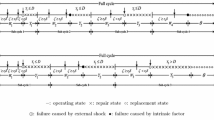Abstract
In this paper, a bivariate replacement policy (n, T) for a cumulative shock damage process is presented that included the concept of cumulative repair cost limit. The arrival shocks can be divided into two kinds of shocks. Each type-I shock causes a random amount of damage and these damages are additive. When the total damage exceeds a failure level, the system goes into serious failure. Type-II shock causes the system into minor failure and such a failure can be corrected by minimal repair. When a minor failure occurs, the repair cost will be evaluated and minimal repair is executed if the accumulated repair cost is less than a predetermined limit L. The system is replaced at scheduled time T, at n-th minor failure, or at serious failure. The long-term expected cost per unit time is derived using the expected costs as the optimality criterion. The minimum-cost policy is derived, and existence and uniqueness of the optimal \( n^{*} \) and \( T^{*} \) are proved. This bivariate optimal replacement policy (n, T) is showed to be better than the optimal \( T^{*} \) and the optimal \( n^{*} \) policy.
Similar content being viewed by others
References
Nakagawa T 2007 Shock and damage models in reliability theory. London: Springer-Verlag
Feldman R M 1976 Optimal replacement with semi-Markov shock models. J. Appl. Probability 13: 108–117
Nakagawa T 1976 On a replacement problem of a cumulative damage model. Operat. Res. 27(4): 895–900
Satow T, Teramoto K and Nakagawa T 2000 Optimal replacement policy for a cumulative damage model with time deterioration. Math. Comput. Model., 31(10–12): 313–319
Taylor H M 1975 Optimal replacement under additive damage and other failure models. Naval Res. Logist. 22(1): 1–18
Mizuno N 1986 Generalized mathematical programming for optimal replacement in a Semi-Markov shock model. Operat. Res. 34: 790–795
Nakagawa T 1980 A summary of imperfect preventive maintenance policies with minimal repair. RAIRO Operat. Res. 14: 249–255
Qian C, Nakamura S and Nakagawa T 1999 Cumulative damage model with two kinds of shocks and its application to the backup policy. J. Operat. Res. Soc. Jpn 42: 501–511
Perry D 2000 Control limit policies in a replacement model with additive phase-type distributed damage and linear restoration. Operat. Res. Lett. 27: 127–134
Nakagawa T 1984 A summary of discrete replacement policies. Eur. J. Operat. Res. 17: 382–392
Nakagawa T and Kijima M 1989 Replacement policies for a cumulative damage model. IEEE Trans. Reliab. 38(3): 581–584
Satow T and Nakagawa T 1997 Three replacement models with two kinds of damage. Microelectron. Reliab. 37(6): 909–913
Kijima M and Nakagawa T 1991 A cumulative damage shock model with imperfect preventive maintenance. Naval Res. Logist. 38(2): 145–156
Qian C, Nakamura S and Nakagawa T 2003 Replacement and minimal repair policies for a cumulative damage model with maintenance. Comput. Math. Appl. 46(7): 1111–1118
Qian C H, Ito K and Nakagawa T 2005 Optimal preventive maintenance policies for a shock model with given damage level. J. Quality Maintenance Eng. 11(3): 216–227
Ito K and Nakagawa T 2011 Comparison of three cumulative damage models. Quality Technol. Quantitative Manag. 8(1): 57–66
Zhao X, Zhang H, Qian C, Nakagawa T and Nakamura S 2012 Replacement models for combining additive independent damages. Int. J. Performability Eng. 8: 91–100
Lai M T 2007 A periodical replacement model based on cumulative repair cost limit. Appl. Stochastic Models Business Ind. 26: 455–464
Chien Y H, Sheu S H, and Chang C C 2009 Optimal age-replacement time with minimal repair based on cumulative repair cost limit and random lead time. Int. J. Syst. Sci. 40: 703–715
Chien Y H, Chang C C and Sheu S H 2010 optimal age-replacement model with age-dependent type of failure and random lead time based on a cumulative repair-cost limit policy. Ann. Operat. Res. 181: 723–744
Chang C C, Sheu S H and Chen Y L 2010 Optimal number of minimal repairs before replacement based on a cumulative repair-cost limit policy. Comput. Ind. Eng. 59: 603–610
Chang C C, Sheu S H and Chen Y L 2013 Optimal replacement model with age-dependent failure type based on a cumulative repair-cost limit policy. Appl. Math. Model. 37: 308–317
Sheu S, Chang C C, Chen Y L and Zhang Z G 2010 A periodic replacement model based on cumulative repair-cost limit for a system subjected to shocks. IEEE Trans. Reliab. 59: 374–382
Sheu S H, Chang C C, Zhang Z G and Chien Y H 2012 A note on replacement policy for a system subject to non-homogeneous pure birth shocks. Eur. J. Operat. Res. 216: 503–508
Sheu S H, Chen Y L, Chang C C and Zhang Z G 2013 Extended optimal replacement policy for a system subject to non-homogeneous pure birth shocks. Comput. Ind. Eng. 64: 573–579
Savits T H 1988 Some multivariate distributions derived from a non-fatal shock model. J. Appl. Probability 25: 383–390
Barlow R E and Proschan F 1975 Statistical theory of reliability and life testing probability models. Holt, Rinehart and Winston, New York
Gottlieb G 1980 Failure distributions of shock models. J. Appl. Probability 25: 745–752
Ross S M 1983 Applied probability models with optimization applications. Holden-Day, San Francisco
Park K S 1987 Optimal number of minor failures before replacement. Int. J. Syst. Sci. 18: 333–337
Badia F D and Berrade M D 2009 Opportunity-based age replacement for a system under two types of failures. In: Martorell et al (eds) Safety, reliability and risk analysis: Theory, methods and applications. Taylor & Francis Group, London, 575–580
Acknowledgments
This research was supported by the Ministry of Science and Technology of Taiwan, under Grant No. MOST 104-2410-H-218 -012 -MY2.
Author information
Authors and Affiliations
Corresponding author
Rights and permissions
About this article
Cite this article
Lai, MT., Chen, SC. A bivariate optimal replacement policy with cumulative repair cost limit under cumulative damage model. Sādhanā 41, 497–505 (2016). https://doi.org/10.1007/s12046-016-0487-6
Received:
Revised:
Accepted:
Published:
Issue Date:
DOI: https://doi.org/10.1007/s12046-016-0487-6



